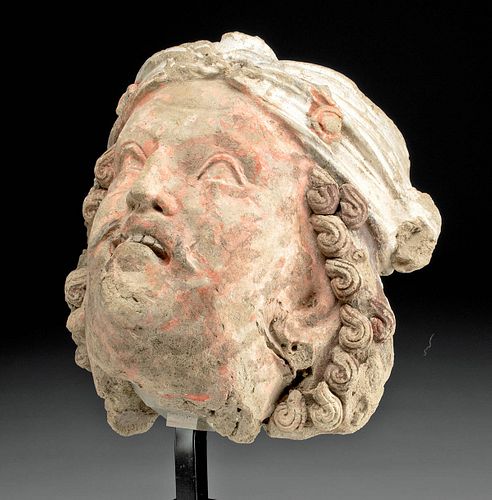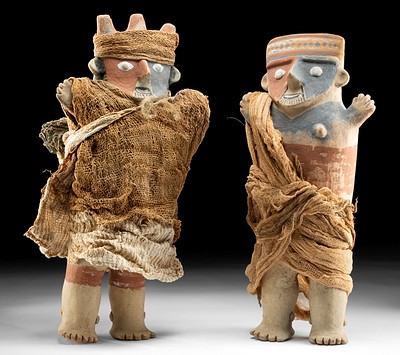2nd C. Gandharan Stucco Head Bodhisattva with Turban
Lot 61b
About Seller
Artemis Fine Arts
686 S Taylor Ave, Ste 106
Louisville, CO 80027
United States
Selling antiquities, ancient and ethnographic art online since 1993, Artemis Gallery specializes in Classical Antiquities (Egyptian, Greek, Roman, Near Eastern), Asian, Pre-Columbian, African / Tribal / Oceanographic art. Our extensive inventory includes pottery, stone, metal, wood, glass and textil...Read more
Categories
Estimate:
$11,000 - $16,500
Absentee vs Live bid
Two ways to bid:
- Leave a max absentee bid and the platform will bid on your behalf up to your maximum bid during the live auction.
- Bid live during the auction and your bids will be submitted real-time to the auctioneer.
Bid Increments
| Price | Bid Increment |
|---|---|
| $0 | $25 |
| $300 | $50 |
| $1,000 | $100 |
| $2,000 | $250 |
| $5,000 | $500 |
| $10,000 | $1,000 |
| $20,000 | $2,500 |
| $50,000 | $5,000 |
| $100,000 | $10,000 |
| $200,000 | $20,000 |
About Auction
By Artemis Fine Arts
May 19, 2022
Set Reminder
2022-05-19 10:00:00
2022-05-19 10:00:00
America/New_York
Bidsquare
Bidsquare : Fine Antiquities | Ethnographica | Fine Art
https://www.bidsquare.com/auctions/artemis-gallery/fine-antiquities-ethnographica-fine-art-9350
Featuring a very special collection of Fine Art from the Hollywood Hills, including Picasso & Rookwood ceramics! Also included are many fine examples of classical antiquities, ancient, and ethnographic art from cultures encompassing the globe. Artemis Fine Arts info@artemisgallery.com
Featuring a very special collection of Fine Art from the Hollywood Hills, including Picasso & Rookwood ceramics! Also included are many fine examples of classical antiquities, ancient, and ethnographic art from cultures encompassing the globe. Artemis Fine Arts info@artemisgallery.com
- Lot Description
Central Asia, Pakistan, India, and Afghanistan, Gandharan culture, ca. 2nd to 3rd century CE. A rare and remarkable stucco head of a man, likely a Bodhisattva, adorned in vivid hues of peach, powder blue, cerise, chocolate, and cream. The expressive visage tilts skywards, appearing awestruck as he displays a wrinkled forehead above arched brows, naturalistic, almond-shaped eyes that gaze upward, an aquiline nose, full cheeks, and fleshy, bowed lips held open to expose a top row of carefully delineated, tab-shaped teeth, as though left speechless in astonishment. A petite, curved moustache with pointed tips flanks his gaping mouth. The realism of this ancient figure is not only accentuated by the fervor of his expression, but also by the lifelike detail of his features, such as the folds of flesh making up his thick neck, his billowing, elongated earlobes, and the finely modelled ringlets that comprise the luscious locks of his coiffure, cascading out from below his plaited turban. A series of 4 circular embellishments additionally adorn his headdress. Size: 7.8" L x 7.3" W x 8.5" H (19.8 cm x 18.5 cm x 21.6 cm); 15.3" H (38.9 cm) on included custom stand.
Alexander the Great conquered Gandhara in 330 BCE and, with the help of the Indo-Greek kings, introduced classical traditions that would influence Gandharan art for the following seven centuries. The stylized curly Mediterranean hair of this head derives from classical sculptures such as the Apollo Belvedere (330 BCE), and the sensitive modeling of the expressive face demonstrates a classical influence as well.
Regardless of the Greek control of Gandhara, the ancient region remained a major center of Buddhism in the Indian subcontinent from the 3rd century BCE to around 1200 CE. According to Buddhist beliefs, bodhisattvas are among the most compassionate beings in the universe, devoting themselves to saving the suffering and helping others achieve enlightenment and Buddhahood. Traditionally depicted as less austere than Buddhas with graceful postures and elegant garments, a nod to the riches of the Northwestern Chinese Silk Road, this piece is no exception. Bodhisattvas or Guanyin are associated with compassion and mercy - their long ears significant because they rescue all human beings by hearing their cries for help and the sounds of suffering.
Gandharans are famous for schist and stucco carvings, with stucco replacing schist as the dominant sculptural material around the 3rd century CE. Vast monastic institutions like those at Takht-i-Bahi, Sahri-Bahlol, Jamal Garhi, Ranigat, and Thareli were decorated by skilled artisans with stucco representations of important figures, religious scenes, and artistic dedications. Stucco allowed artists more freedom in portraying lifelike features, as shown in the gentle curve of the brow here. During this time, Gandhara was exceptionally wealthy, profiting from trade along the Silk Road; patrons had resources to spend on the arts, creating a flowering of stucco artwork. Some monumental statues had stucco hands, feet, and heads alongside clay torsos - the size of these figures was such that clay was needed to maintain their form.
This piece has been searched against the Art Loss Register database and has been cleared. The Art Loss Register maintains the world's largest database of stolen art, collectibles, and antiques.
Provenance: private Hawaii, USA collection, acquired 1995 to 2010; ex-Harlan J. Berk collection, New York, USA, acquired 1950 to 1960
All items legal to buy/sell under U.S. Statute covering cultural patrimony Code 2600, CHAPTER 14, and are guaranteed to be as described or your money back.
A Certificate of Authenticity will accompany all winning bids.
PLEASE NOTE: Due to recent increases of shipments being seized by Australian & German customs (even for items with pre-UNESCO provenance), we will no longer ship most antiquities and ancient Chinese art to Australia & Germany. For categories of items that are acceptable to ship to Australia or Germany, please contact us directly or work with your local customs brokerage firm.
Display stands not described as included/custom in the item description are for photography purposes only and will not be included with the item upon shipping.
#168413Fragment of a larger figure. Repaired from several pieces with restoration over break lines. Expected chips, nicks, and abrasions throughout, commensurate with age. Otherwise, excellent with impressive remains of pigment.Condition
- Shipping Info
-
All shipping is handled in-house for your convenience. Your invoice from Artemis Gallery will include shipping calculation instructions. If in doubt, please inquire BEFORE bidding for estimated shipping costs for individual items.
-
- Buyer's Premium



 EUR
EUR CAD
CAD AUD
AUD GBP
GBP MXN
MXN HKD
HKD CNY
CNY MYR
MYR SEK
SEK SGD
SGD CHF
CHF THB
THB















